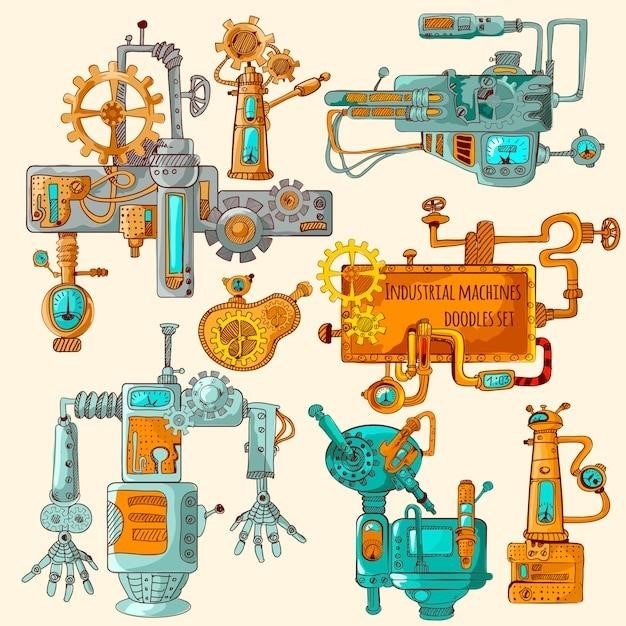
Nikola Tesla’s “My Inventions”⁚ A Look into the Mind of a Genius
Nikola Tesla’s autobiography, “My Inventions,” offers a unique glimpse into the mind of this visionary inventor. Published in 1919, the book provides a personal account of his groundbreaking discoveries and inventions, including his work on alternating current (AC) power systems, the Tesla coil, and wireless energy transmission. “My Inventions” serves as a testament to Tesla’s genius and his enduring legacy on modern technology.
Early Life and Education
Nikola Tesla’s early life and education played a pivotal role in shaping his extraordinary mind. Born in Smiljan, Croatia, on July 10, 1856, Tesla’s early years were steeped in a blend of scientific curiosity and a love for nature. His father, Milutin Tesla, was a Serbian Orthodox priest, while his mother, Djuka Mandic, possessed a remarkable talent for invention and a strong influence on her son’s intellectual development. Tesla’s fascination with electricity sparked at an early age, fueled by his mother’s ingenious inventions, such as a small mechanical device for churning butter. He received his early education at home, excelling in his studies and exhibiting an exceptional aptitude for mathematics and physics.
Tesla’s formal education continued at the Higher Real Gymnasium in Karlovac, Croatia, where he further honed his academic skills. He then enrolled at the Austrian Polytechnic in Graz, Austria, to pursue a degree in electrical engineering. However, his academic path took an unexpected turn when he clashed with his professors over their adherence to direct current (DC) technology, a system that Tesla believed was inefficient. Tesla’s independent spirit and unwavering belief in the potential of alternating current (AC) led him to leave the Polytechnic before completing his degree. Undeterred by this setback, he continued his self-directed studies, driven by an insatiable thirst for knowledge and an unwavering belief in his own ideas. Tesla’s early life and education laid the foundation for his extraordinary career as an inventor, characterized by his unconventional thinking, relentless pursuit of innovation, and unwavering commitment to advancing the field of electrical engineering.
Tesla’s Contributions to Alternating Current
Nikola Tesla’s most significant contribution to the world of electricity was his pioneering work on alternating current (AC) power systems. In stark contrast to the prevailing direct current (DC) systems championed by Thomas Edison, Tesla recognized the superior efficiency and scalability of AC power. His visionary ideas challenged the established norms of the time, setting the stage for a paradigm shift in electrical engineering. Tesla’s groundbreaking inventions, such as the polyphase AC induction motor, the Tesla coil, and the AC power system, revolutionized the way electricity was generated, transmitted, and utilized. His revolutionary polyphase AC induction motor, developed in the 1880s, eliminated the need for commutators and brushes, making it a far more efficient and reliable alternative to existing DC motors. This breakthrough paved the way for the widespread adoption of AC power, transforming the landscape of electrical engineering and ushering in a new era of technological advancement.
Tesla’s unwavering commitment to AC power, coupled with his innovative inventions, sparked a fierce rivalry with Thomas Edison, known as the “War of Currents.” Despite Edison’s initial resistance, Tesla’s vision ultimately prevailed, as AC power proved to be the superior choice for long-distance power transmission. Tesla’s groundbreaking work in AC power systems laid the foundation for the modern electrical grid, enabling the efficient distribution of electricity to homes, businesses, and industries worldwide. His contributions to AC power systems continue to shape the world we live in today, powering our homes, businesses, and transportation systems, a testament to his visionary genius and enduring impact on the field of electrical engineering.
The Tesla Coil and Its Applications
One of Nikola Tesla’s most intriguing inventions is the Tesla coil, a resonant transformer circuit that generates high-voltage, high-frequency alternating current electricity. This ingenious device, patented in 1891, has captivated the imagination of scientists and enthusiasts alike, showcasing the remarkable potential of electrical energy. The Tesla coil operates on the principle of resonance, where the primary and secondary coils are tuned to resonate at the same frequency, amplifying the voltage and creating spectacular displays of electrical discharges. Tesla’s vision for the Tesla coil extended beyond mere scientific curiosity. He envisioned its use in wireless energy transmission, envisioning a world where power could be transmitted without the need for wires, a concept that continues to inspire researchers and engineers today.
While Tesla’s dream of wireless power transmission remains a work in progress, the Tesla coil has found diverse applications in various fields. Its ability to generate high-voltage, high-frequency electricity has made it a valuable tool in medical imaging, radio technology, and industrial processes. In medical imaging, Tesla coils are employed in magnetic resonance imaging (MRI) machines, which use powerful magnetic fields and radio waves to create detailed images of the inside of the human body. In radio technology, Tesla coils are used in radio transmitters to generate high-frequency radio waves that carry information over long distances. In industrial processes, Tesla coils are employed in applications such as high-voltage testing, surface hardening, and plasma generation. The Tesla coil’s enduring legacy lies in its ability to inspire innovation and push the boundaries of electrical engineering, proving that Tesla’s visionary ideas continue to resonate in the modern world.
Wireless Energy Transmission⁚ A Visionary Concept
Nikola Tesla’s vision of a world powered by wireless energy transmission was a radical concept that challenged the conventional thinking of his time. In his autobiography, “My Inventions,” Tesla passionately describes his experiments and theories on wireless power, a topic that fascinated him throughout his life. Tesla believed that the Earth itself could act as a conductor, enabling the transmission of energy over vast distances without the need for wires. He envisioned a future where power could be beamed from central stations to homes, businesses, and even ships at sea, eliminating the need for cumbersome power lines and cables. Tesla’s “Magnifying Transmitter,” a massive resonant transformer designed to transmit power wirelessly, was a testament to his unwavering belief in this visionary concept.
Despite his groundbreaking work and numerous experiments, Tesla’s dream of wireless energy transmission remained largely unrealized during his lifetime. The technological limitations of the time and the lack of sufficient funding hindered the full realization of his ambitious vision. However, Tesla’s ideas on wireless power continue to inspire researchers and engineers today. Modern advancements in wireless power technologies, such as inductive charging and resonant induction, are rooted in Tesla’s pioneering work. While Tesla’s vision of a world powered by wireless energy transmission may not be fully realized yet, his groundbreaking ideas continue to spark innovation and inspire future generations to explore the possibilities of wireless power, leaving an enduring legacy of scientific curiosity and technological ambition.
The Tesla Turbine⁚ A Revolutionary Design
In his autobiography, “My Inventions,” Nikola Tesla dedicates a significant portion to his ingenious invention, the Tesla turbine. This revolutionary design, a bladeless turbine, challenged the conventional wisdom of the time and presented a unique approach to energy conversion. Unlike traditional turbines that rely on blades to harness the energy of fluids, the Tesla turbine operates on the principle of boundary layer effect. Fluid is drawn into the turbine through a series of closely spaced disks. The fluid’s viscosity creates friction between the fluid layers, causing the disks to spin, generating power. This frictionless design eliminated the need for blades, which were prone to wear and tear, reducing maintenance requirements and increasing efficiency.
The Tesla turbine’s simplicity and efficiency were particularly attractive for applications requiring high-speed operation and low maintenance, such as in pumps, compressors, and high-speed engines. However, despite its potential, the Tesla turbine never gained widespread commercial success. The complexities of scaling up the design for industrial applications and the limitations of its power output compared to conventional turbines ultimately hindered its wider adoption. Nevertheless, the Tesla turbine remains a testament to Tesla’s innovative spirit and his ability to think outside the box, pushing the boundaries of conventional engineering. His groundbreaking design continues to inspire engineers and researchers today, finding applications in specialized niches, highlighting its enduring potential in specific areas of engineering and technology.
Tesla’s Other Inventions and Ideas
Beyond his well-known contributions to alternating current and the Tesla coil, Nikola Tesla’s “My Inventions” reveals a mind brimming with diverse ideas and inventive pursuits. His autobiography delves into a wide range of inventions and concepts that demonstrate his insatiable curiosity and his relentless pursuit of technological advancement. Among his lesser-known inventions, Tesla explored the realm of wireless energy transmission, envisioning a world powered by wireless energy. He experimented with magnifying transmitters, aiming to transmit power wirelessly over long distances, a concept that remains a topic of research and debate today.
Tesla also envisioned a “death ray,” a weapon capable of transmitting a powerful beam of energy, although this project was never fully realized. He even delved into the realm of robotics, developing remote-controlled boats and investigating the possibilities of artificial intelligence. Tesla’s “My Inventions” showcases his multifaceted nature, a genius who explored the frontiers of science and technology, pushing the boundaries of human ingenuity. His autobiography reveals a mind that embraced both the practical and the visionary, leaving behind a legacy of groundbreaking inventions and audacious ideas that continue to inspire generations of inventors and researchers.

The Tesla-Edison “War of Currents”
Tesla’s “My Inventions” sheds light on the famous “War of Currents,” a fierce rivalry between Nikola Tesla and Thomas Edison, who championed competing electrical systems. Edison, a proponent of direct current (DC), saw Tesla’s alternating current (AC) system as a threat to his established technology and business interests. The rivalry intensified as Tesla developed and promoted his AC system, which offered advantages in terms of efficiency and transmission over long distances. Tesla’s autobiography provides insights into his perspective on this historical conflict, highlighting the technical and commercial battles that ensued.
The “War of Currents” involved public demonstrations, patent disputes, and a fierce battle for market share. Tesla’s “My Inventions” details his efforts to overcome Edison’s opposition, showcasing his determination and belief in the superiority of his AC system. The rivalry ultimately ended with the triumph of Tesla’s AC system, which became the standard for electrical power generation and distribution worldwide. The “War of Currents” stands as a testament to the competitive spirit of innovation and the impact of Tesla’s pioneering work on the future of electrical engineering.
Tesla’s Legacy and Impact on Modern Technology
Tesla’s “My Inventions” not only recounts his groundbreaking discoveries but also underscores their enduring impact on modern technology; His contributions to alternating current (AC) power systems, including the development of the polyphase AC motor, revolutionized the way electricity is generated, transmitted, and used. This fundamental shift in power technology laid the foundation for the electrification of modern society, powering homes, industries, and transportation systems across the globe.

Beyond AC, Tesla’s inventions and ideas, such as the Tesla coil, wireless energy transmission, and the Tesla turbine, continue to inspire and influence technological advancements. His visionary concepts, including the potential for wireless communication and the harnessing of renewable energy sources, have resonated with generations of scientists and engineers. Tesla’s “My Inventions” serves as a testament to his visionary thinking, emphasizing the enduring relevance of his work to the future of technology.
“My Inventions” as an Autobiography
While “My Inventions” primarily focuses on Tesla’s scientific and technical achievements, it also offers a glimpse into his personal life and perspectives. Published in 1919, the book provides a unique insight into Tesla’s thoughts, motivations, and struggles as an inventor. Tesla’s writing style is both engaging and informative, as he delves into the technical details of his inventions while also reflecting on the challenges and triumphs he faced throughout his career.
Through his personal anecdotes and reflections, Tesla reveals his unwavering belief in the power of imagination and innovation. He emphasizes the importance of perseverance, experimentation, and a relentless pursuit of knowledge. “My Inventions” serves as a testament to Tesla’s dedication to science and his belief in the transformative potential of technology. It offers a compelling and intimate perspective on the life and mind of one of history’s most influential inventors.
The Significance of “My Inventions”
“My Inventions” holds significant importance in understanding Nikola Tesla’s legacy. It provides a direct and personal account of his groundbreaking work from the inventor himself, offering valuable insights into his creative process, scientific philosophies, and vision for the future. The book serves as a primary source for researchers and historians, offering a unique perspective on Tesla’s life and work that complements other biographical accounts and technical publications.
Moreover, “My Inventions” serves as a testament to Tesla’s enduring influence on modern technology. His insights into alternating current, wireless energy transmission, and other innovative concepts continue to inspire engineers and scientists today. The book’s publication in 1919, a time when Tesla’s contributions were not fully recognized, highlights the importance of preserving and sharing his ideas for future generations to appreciate and learn from. “My Inventions” remains a valuable resource for understanding the legacy of one of history’s most brilliant minds.
Tesla’s Vision for the Future
Throughout “My Inventions,” Tesla’s vision for the future shines through. He saw a world powered by wireless energy, where communication was instantaneous and global, and where technology would improve the quality of life for all. His ideas about wireless energy transmission, for instance, were not merely theoretical musings but practical ambitions. He envisioned a world where electricity could be harnessed and distributed without wires, eliminating the need for power lines and enabling the electrification of remote areas.
Tesla’s vision extended beyond mere technological advancement. He believed that technology could be a force for good, promoting peace and prosperity. He saw a future where machines would perform laborious tasks, freeing humans to pursue higher intellectual and creative endeavors. His desire to improve the human condition through innovation is a recurring theme in “My Inventions,” showcasing his belief in the transformative power of technology and its potential to shape a better future for humanity.
The enduring Mystery of Nikola Tesla
Despite his prolific contributions, Tesla remains shrouded in an aura of mystery. His eccentric personality, unconventional ideas, and enigmatic pronouncements about his work have fueled speculation and intrigue. “My Inventions,” while offering insights into his scientific endeavors, also hints at a complex and often misunderstood individual. He was known for his meticulousness, his obsession with cleanliness, and his aversion to jewelry, even going so far as to avoid touching human hair.
Furthermore, Tesla’s fascination with the esoteric and the metaphysical, evident in his writings about “radiant energy,” “cosmic rays,” and the “ether,” added to his enigmatic persona. These interests, while often dismissed as fringe science, highlight a side of Tesla that remains elusive and intriguing. “My Inventions” serves as a window into this complex and captivating figure, leaving readers with more questions than answers about the man behind the inventions.
The Continuing Relevance of Tesla’s Work
While Tesla’s life and work may seem like relics of a bygone era, their relevance continues to resonate in the 21st century. His pioneering work in alternating current (AC) power systems laid the foundation for the modern electrical grid, powering homes, businesses, and industries worldwide. His inventions, such as the Tesla coil, remain fundamental to radio technology, wireless communication, and medical imaging. The Tesla turbine, with its unique design, offers potential for more efficient and sustainable energy production.
Beyond his technical achievements, Tesla’s visionary concepts continue to inspire innovation. His pursuit of wireless energy transmission, though not fully realized in his lifetime, has fueled modern research into wireless power transfer and its applications. Tesla’s emphasis on sustainable energy solutions, such as harnessing the power of nature, resonates strongly with contemporary efforts to address climate change. “My Inventions” serves as a reminder that Tesla’s legacy extends far beyond his individual inventions, shaping the technological landscape of the future.





No comment yet, add your voice below!